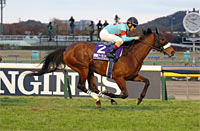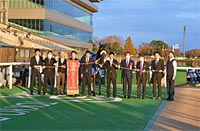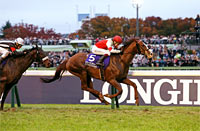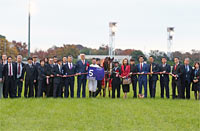Japan Cup (G1) - Data Analysis
Champion decider bringing together elite Japanese & foreign runners
Of the 37 Japan Cup winners to date, a total of 33 were horses that had experience finishing in the Top 2 of a G1 race held in Japan or overseas (the exceptions being Half Iced in 1982, Jupiter Island in 1986, Marvelous Crown in 1994, and Screen Hero in 2008). The Japan Cup is a world-renowned race typically won by runners that have already vied for top positions in major domestic or overseas races. Foreign and Japanese horses respectively won 12 and 5 of the Japan Cup races from 1981 (launch year) to 1997, but since 1998 to 2017, 18 Japanese runners have won the race, while only two from abroad have claimed the title. In other words, Japanese horses have enjoyed notably greater success in recent years. Let’s now analyze some features shared by successful runners in this race based on results over the last 10 years.
Focus on runners that have enjoyed success in G1 races held at Tokyo or Kyoto Racecourse
Of the 30 Top 3 finishers over the last 10 years, 29 (excluding 2008 winner Screen Hero) had experience finishing in the Top 4 of a “G1 race held at the Tokyo or Kyoto Racecourse.” In addition, runners that had triumphed in a “G1 race held at the Tokyo or Kyoto Racecourse” achieved an excellent Top 3 ratio of 39.6%. When looking at the track record of this year’s runners, we should check their performances in a major race held at Tokyo Racecourse or Kyoto Racecourse. [Table 1]
[Table 1] Performance by highest finish in a “G1 race held at the Tokyo or Kyoto Racecourse” (last 10 years)
| Highest finish |
Performance
[1st-2nd-3rd-4th or lower] |
Win ratio |
Top 2 ratio |
Top 3 ratio |
| 1st |
7-7-7-32 |
13.2% |
26.4% |
39.6% |
| 2nd-4th |
2-3-3-36 |
4.5% |
11.4% |
18.2% |
5th or lower;
no such race entered |
1-0-0-75 |
1.3% |
1.3% |
1.3% |
Track record from April of same year also important
Of the 30 Top 3 finishers over the last 10 years, 29 (excluding 2013 third-place finisher Tosen Jordan) had experience finishing in the Top 4 of “a JRA G1 or G2 race held from April of the same year.” In other words, we should expect little from runners without recent successes and those that mainly competed in races other than JRA G1 and G2 races. [Table 2]
[Table 2] Performance by experience finishing in Top 4 of “JRA G1 or G2 race held from April of same year” (last 10 years)
| Experience |
Performance
[1st-2nd-3rd-4th or lower] |
Win ratio |
Top 2 ratio |
Top 3 ratio |
| Yes |
10-10-9-70 |
10.1% |
20.2% |
29.3% |
| No |
0-0-1-73 |
0% |
0% |
1.4% |
Runners aged 6 and above struggle
All 20 Top 2 finishers over the last 10 years were “horses aged 5 or less.” Meanwhile, “horses aged 6 or above” achieved a Top 3 ratio of only 4.3%. We should therefore lower our expectations of horses aged 6 and above. [Table 3]
[Table 3] Performance by age (last 10 years)
| Age |
Performance
[1st-2nd-3rd-4th or lower] |
Win ratio |
Top 2 ratio |
Top 3 ratio |
| 3 |
2-3-2-21 |
7.1% |
17.9% |
25.0% |
| 4 |
5-3-2-41 |
9.8% |
15.7% |
19.6% |
| 5 |
3-4-4-36 |
6.4% |
14.9% |
23.4% |
| 6 |
0-0-0-24 |
0% |
0% |
0% |
| 7 |
0-0-2-12 |
0% |
0% |
14.3% |
| 8 |
0-0-0-9 |
0% |
0% |
0% |
| 5 or less |
10-10-8-98 |
7.9% |
15.9% |
22.2% |
| 6 or above |
0-0-2-45 |
0% |
0% |
4.3% |
In addition, all 30 Top 3 finishers over the last 10 years had “25 career starts or less.” This means that, in addition to horses aged 6 and above, horses with longer careers are unlikely to chase the top places. [Table 4]
[Table 4] Performance by career starts (past 10 years)
| Career starts |
Performance
[1st-2nd-3rd-4th or lower] |
Win ratio |
Top 2 ratio |
Top 3 ratio |
| 25 or less |
10-10-10-100 |
7.7% |
15.4% |
23.1% |
| 26 or more |
0-0-0-43 |
0% |
0% |
0% |
Zero Top 3 finishes for foreign horses in last 11 years
All 30 Top 3 finishers over the last 10 years have been Japanese horses. The last foreign horse to finish in the Top 3 was Ouija Board (third place in 2006). In other words, our primary focus should again be on Japanese horses this year. [Table 5]
[Table 5] Performance by country affiliation (last 10 years)
| Country affiliation |
Performance
[1st-2nd-3rd-4th or lower] |
Win ratio |
Top 2 ratio |
Top 3 ratio |
| Japan |
10-10-10-101 |
7.6% |
15.3% |
22.9% |
| Foreign |
0-0-0-42 |
0% |
0% |
0% |
Foreign-affiliated jockeys perform well
Looking at performances of Japanese runners over the last 10 years in terms of jockey country affiliation, we observe that horses ridden by foreign-affiliated jockeys achieved an excellent Top 3 ratio of 36.7%. While foreign horses struggled, we should raise our expectations of Japanese horses ridden by foreign-affiliated jockeys. [Table 6]
[Table 6] Performance by jockey country affiliation for Japanese horses (last 10 years)
Jockey
country affiliation |
Performance
[1st-2nd-3rd-4th or lower] |
Win ratio |
Top 2 ratio |
Top 3 ratio |
| Japan |
5-7-7-82 |
5.0% |
11.9% |
18.8% |
| Foreign |
5-3-3-19 |
16.7% |
26.7% |
36.7% |
Note: Mirco Demuro and Christophe Lemaire obtained permanent JRA licenses in 2015. Accordingly, their country affiliation changed from “foreign” (2014 and before) to “Japan” from 2015.
Seek out the winner!
Check conditions for previous race
The last nine winners of the Japan Cup all (1) had finished in the Top 2 of “a G1 race held at the Tokyo Racecourse or Kyoto Racecourse,” (2) had finished in the Top 3 of “a G1 or G2 race held from April of the same year,” (3) were horses aged 5 or less, (4) had 24 career starts or less, and (5) were Japanese horses. Any runner that clears all of the conditions outlined in Tables 1-5 above must therefore be regarded as a leading contender. Other features shared by the nine recent winners were that they had contested a JRA race in their previous race, that they had finished in the Top 6 of their previous race, that they had been backed as 5th favorite or higher in their previous race, and that they were ranked “6th or higher” in the estimated time over the final three furlongs in their previous race. In other words, we should carefully check performances in the previous race. [Table 7]
[Table 7] Winners’ “highest finish in G1 race held at Tokyo or Kyoto Racecourse,” “highest finish in JRA G1 or G2 race held from April of the same year,” “age,” “career starts,” “country affiliation,” “previous race,” “finish in previous race,” “favoritism in previous race,” “ranking in estimated time over final 3 furlongs in previous race” (last 9 years)
| Year |
Winner |
Highest finish in “G1 race held at Tokyo or Kyoto Racecourse” |
Highest finish in “JRA G1 or G2 race held from April of same year” |
Age |
Career
starts |
Country
affiliation |
Previous
race |
Finish in
previous
race |
Favoritism
in previous
race |
Ranking in
estimated
time over
final 3F in
previous race |
| 2009 |
Vodka |
1st (2009 Yasuda Kinen, etc.) |
1st (2009 Yasuda Kinen, etc.) |
5 |
24 |
Japan |
Tenno Sho (Autumn) |
3rd |
1st |
1st |
| 2010 |
Rose Kingdom |
2nd (2010 Kikuka Sho, etc.) |
1st (2010 Kobe Shimbun Hai) |
3 |
8 |
Japan |
Kikuka Sho |
2nd |
1st |
2nd |
| 2011 |
Buena Vista |
1st (2010 Tenno Sho (Autumn), etc.) |
2nd (2011 Takarazuka Kinen, etc.) |
5 |
21 |
Japan |
Tenno Sho (Autumn) |
4th |
1st |
3rd |
| 2012 |
Gentildonna |
1st (2012 Shuka Sho, etc.) |
1st (2012 Shuka Sho, etc.) |
3 |
8 |
Japan |
Shuka Sho |
1st |
1st |
3rd |
| 2013 |
Gentildonna |
1st (2012 Japan Cup, etc.) |
2nd (2013 Tenno Sho (Autumn)) |
4 |
12 |
Japan |
Tenno Sho (Autumn) |
2nd |
1st |
3rd |
| 2014 |
Epiphaneia |
1st (2013 Kikuka Sho) |
3rd (2014 Sankei Osaka Hai) |
4 |
11 |
Japan |
Tenno Sho (Autumn) |
6th |
4th |
5th |
| 2015 |
Shonan Pandora |
1st (2014 Shuka Sho) |
1st (2015 All Comers) |
4 |
15 |
Japan |
Tenno Sho (Autumn) |
4th |
5th |
1st |
| 2016 |
Kitasan Black |
1st (2016 Tenno Sho (Spring), etc.) |
1st (2016 Kyoto Daishoten, etc.) |
4 |
12 |
Japan |
Kyoto Daishoten |
1st |
1th |
6th |
| 2017 |
Cheval Grand |
2nd (2017 Tenno Sho (Spring)) |
2nd (2017 Tenno Sho (Spring)) |
5 |
21 |
Japan |
Kyoto Daishoten |
3rd |
1th |
3rd |
(Masaya Ibuki)
|




















